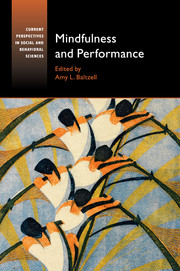Book contents
- Frontmatter
- Dedication
- Epigraph
- Contents
- List of figures
- List of tables
- List of contributors
- Preface
- Acknowledgments
- I INTRODUCTION TO MINDFULNESS: HISTORY AND THEORETICAL UNDERSTANDING
- 1 Mindfulness Scholarship and Interventions: A Review
- 2 Mindfulness, Emotion Regulation, and Performance
- 3 Self-Compassion, Distress Tolerance, and Mindfulness in Performance
- 4 Flow and Mindfulness in Performance
- 5 Peak Performance: Langerian Mindfulness and Flow
- 6 Langerian Mindfulness and Liminal Performing Spaces
- II FORMAL MINDFULNESS INTERVENTIONS IN SPORT
- III MINDFULNESS: THEORY TO PRACTICE IN SPORT AND EXERCISE
- IV MINDFULNESS AND THE PERFORMING ARTS
- V MINDFULNESS FOR COACHES, PRACTITIONERS, AND MENTORS
- VI FUTURE DIRECTIONS
- Index
- References
4 - Flow and Mindfulness in Performance
from I - INTRODUCTION TO MINDFULNESS: HISTORY AND THEORETICAL UNDERSTANDING
Published online by Cambridge University Press: 05 January 2016
- Frontmatter
- Dedication
- Epigraph
- Contents
- List of figures
- List of tables
- List of contributors
- Preface
- Acknowledgments
- I INTRODUCTION TO MINDFULNESS: HISTORY AND THEORETICAL UNDERSTANDING
- 1 Mindfulness Scholarship and Interventions: A Review
- 2 Mindfulness, Emotion Regulation, and Performance
- 3 Self-Compassion, Distress Tolerance, and Mindfulness in Performance
- 4 Flow and Mindfulness in Performance
- 5 Peak Performance: Langerian Mindfulness and Flow
- 6 Langerian Mindfulness and Liminal Performing Spaces
- II FORMAL MINDFULNESS INTERVENTIONS IN SPORT
- III MINDFULNESS: THEORY TO PRACTICE IN SPORT AND EXERCISE
- IV MINDFULNESS AND THE PERFORMING ARTS
- V MINDFULNESS FOR COACHES, PRACTITIONERS, AND MENTORS
- VI FUTURE DIRECTIONS
- Index
- References
Summary
When in flow, everything comes together and actions follow actions seamlessly, creating high levels of task performance. Flow creates order out of chaos, complexity out of the ordinary, and, most importantly, experiences that are optimal. It is the feeling of being in flow that draws people back to this state. It is what is created when in flow that contributes to the most enjoyable moments of one's life. The flow model also provides a way of understanding an optimal mindset for performance.
Much has been written about flow, its attributes and benefits, and I will summarise some of this work, including some of my research on flow, in this chapter. However, a link that has been receiving growing empirical attention is that between flow and mindfulness. Having worked in both areas in the fields of performance psychology and in yoga/meditation, and having found a synchronicity between the two constructs as an applied practitioner, I would like to share a bit about why I believe flow is important to mindfulness, and mindfulness to flow. Some of the recent research that has been examining relationships between flow and mindfulness will be overviewed and possible directions for future research and applied initiatives outlined.
What Is Flow?
Csikszentmihalyi (1975, 1990) developed the flow concept after investigating the experiences of individuals during times when they were totally involved in what they were doing and when everything came together during their performances. Csikszentmihalyi has operationally defined flow as being a psychological state that can occur when challenges and skills in a situation are both high. More precisely, flow is predicted to occur when an individual is being extended by virtue of performing in a challenging situation and has a skill level that matches the challenge being faced. Flow occurs when the individual moves beyond his or her average experience of challenge and skill in a situation. The results of being in flow are outstanding levels of performance and memorable experiences.
Challenges and skills play a critical role in understanding flow and, more broadly, a variety of psychological experiences. In what have become known as the four and eight quadrant flow models, a range of psychological experiences have been predicted to result from different mixes of challenges and skills, or more precisely, from the perception of challenges and skills in a situation.
- Type
- Chapter
- Information
- Mindfulness and Performance , pp. 78 - 100Publisher: Cambridge University PressPrint publication year: 2016
References
- 5
- Cited by



